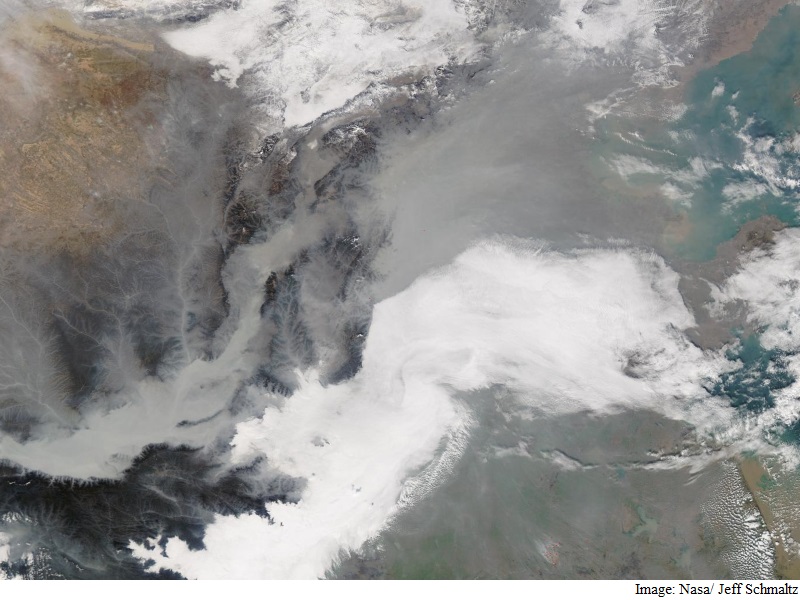- Home
- Science
- Science News
- Earth's Recent History Key to Predicting Global Temperatures: Study
Earth's Recent History Key to Predicting Global Temperatures: Study

To quantify climate change, researchers need to know the Transient Climate Response (TCR) and Equilibrium Climate Sensitivity (ECS) of Earth.
Both values are projected global mean surface temperature changes in response to doubled atmospheric carbon dioxide concentrations but on different timescales.
There have been many attempts to determine TCR and ECS values based on the history of temperature changes over the last 150 years and the measurements of important climate drivers, such as carbon dioxide, researchers said.
As part of that calculation, researchers have relied on simplifying assumptions when accounting for the temperature impacts of climate drivers other than carbon dioxide, such as tiny particles in the atmosphere known as aerosols, for example.
It is well known that aerosols such as those emitted in volcanic eruptions act to cool Earth, at least temporarily, by reflecting solar radiation away from the planet.
In a similar way, land use changes such as deforestation in northern latitudes result in bare land that increases reflected sunlight.
However, assumptions made to account for these drivers are too simplistic and result in incorrect estimates of TCR and ECS, said study co-author Gavin Schmidt, the director of Nasa's Goddard Institute for Space Studies (GISS) in New York.
"The problem with that approach is that it falls way short of capturing the individual regional impacts of each of those variables," he said, adding that only within the last ten years has there been enough available data on aerosols to abandon the simple assumption and instead attempt detailed calculations.
In a Nasa first, researchers at GISS accomplished such a feat as they calculated the temperature impact of each of these variables - greenhouse gases, natural and manmade aerosols, ozone concentrations, and land use changes - based
on historical observations from 1850 to 2005 using a massive ensemble of computer simulations.
Analysis of the results showed that these climate drivers do not necessarily behave like carbon dioxide, which is uniformly spread throughout the globe and produces a consistent temperature response; rather, each climate driver has a particular set of conditions that affects the temperature response of Earth.
Since earlier studies do not account for what amounts to a net cooling effect for parts of the northern hemisphere, TCR and ECS predictions have been lower than they should be.
This means that Earth's climate sensitivity to carbon dioxide - or atmospheric carbon dioxide's capacity to affect temperature change - has been underestimated, researchers said.
The study was published in the journal Nature Climate Change.
For the latest tech news and reviews, follow Gadgets 360 on X, Facebook, WhatsApp, Threads and Google News. For the latest videos on gadgets and tech, subscribe to our YouTube channel. If you want to know everything about top influencers, follow our in-house Who'sThat360 on Instagram and YouTube.
Related Stories
- Samsung Galaxy Unpacked 2025
- ChatGPT
- Redmi Note 14 Pro+
- iPhone 16
- Apple Vision Pro
- Oneplus 12
- OnePlus Nord CE 3 Lite 5G
- iPhone 13
- Xiaomi 14 Pro
- Oppo Find N3
- Tecno Spark Go (2023)
- Realme V30
- Best Phones Under 25000
- Samsung Galaxy S24 Series
- Cryptocurrency
- iQoo 12
- Samsung Galaxy S24 Ultra
- Giottus
- Samsung Galaxy Z Flip 5
- Apple 'Scary Fast'
- Housefull 5
- GoPro Hero 12 Black Review
- Invincible Season 2
- JioGlass
- HD Ready TV
- Laptop Under 50000
- Smartwatch Under 10000
- Latest Mobile Phones
- Compare Phones
- Honor Magic 7 RSR Porsche Design
- Moto G15 Power
- Moto G15
- Realme 14x 5G
- Poco M7 Pro 5G
- Poco C75 5G
- Vivo Y300 (China)
- HMD Arc
- Asus Zenbook S 14
- MacBook Pro 16-inch (M4 Max, 2024)
- Honor Pad V9
- Tecno Megapad 11
- Redmi Watch 5
- Huawei Watch Ultimate Design
- Sony 65 Inches Ultra HD (4K) LED Smart TV (KD-65X74L)
- TCL 55 Inches Ultra HD (4K) LED Smart TV (55C61B)
- Sony PlayStation 5 Pro
- Sony PlayStation 5 Slim Digital Edition
- Blue Star 1.5 Ton 3 Star Inverter Split AC (IC318DNUHC)
- Blue Star 1.5 Ton 3 Star Inverter Split AC (IA318VKU)

















